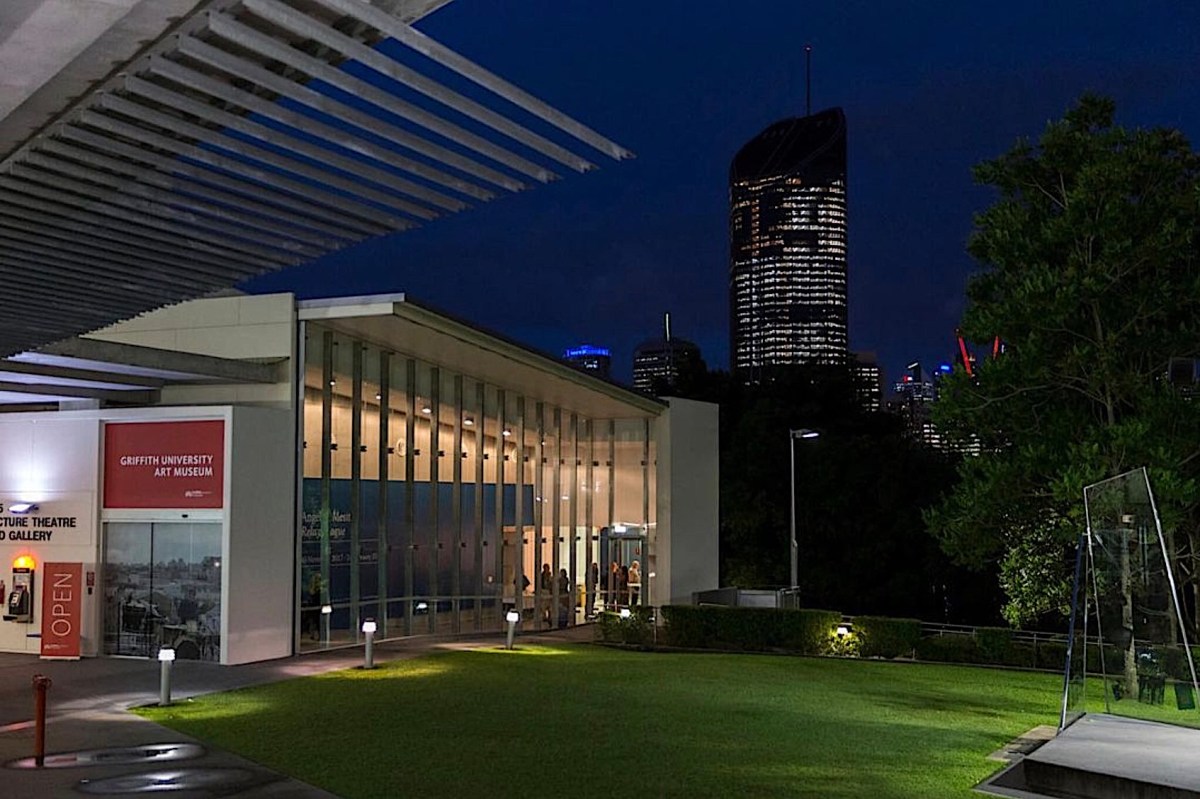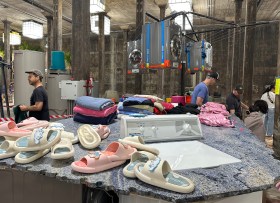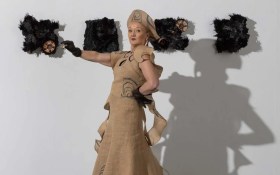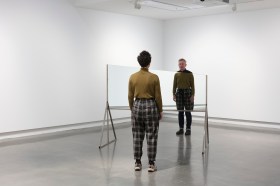Since the announcement last week of the proposed closure of Griffith University Art Museum (GUAM) with an internal consultation period of just two weeks, social media has been flooded with messages of opposition and support for the Museum and its staff from members of the arts community – ranging from arts leaders to industry bodies such as UAMA (University Art Museums Australia), artists (including Queensland’s leading Indigenous art collective proppaNOW) and students.
Citing the need to expand the Griffith Film School as the impetus behind the proposal and the success of the children’s television program Bluey as a reason for its growth in enrolments, the University’s leadership has demonstrated its lack of understanding of the significance of GUAM within the University, its important place within Brisbane’s art ecology and its standing within the visual arts community nationally. It also must be noted that in losing the Museum, Griffith University stands to gain a mere 250 square metres. This seems almost inconceivable for an institution that spans three cities in south-east Queensland and has five physical campuses (Gold Coast, Logan, Mount Gravatt, Nathan and South Bank).
Sadly, as most directors of university art museums (UAMs) understand only too well, UAMs can be vulnerable within their own institutions – often misunderstood as outside the core business of teaching and learning, and regarded as “nice to have”, but not a vital part of the offering of a great university. Every change of university leadership comes with an inevitable holding of breath as art museum directors wait to see if their reporting structures will change, their already comparatively modest budgets will be slashed or, as in the extreme case of GUAM, if they will cease to exist.
The major stakeholder of every UAM is of course its university, and each of the UAMs within Australia work hard to demonstrate and deliver on the strategic aims of their particular institutions. However, most universities rarely state (or revisit) their expectations of the cultural organisations within them and this absence of a clearly defined relationship between the university and its museum can mean that the museum feels as if it is “yelling into the void” in terms of its aspirations, achievements and benefits to the university community and, on behalf of the university, to the broader public. It can also leave the museum and wider community at a loss when the university believes its (unstated) expectations are not being met and makes changes accordingly (in the case of GUAM, for example, university leadership has zeroed in on programming and attendance figures as part of the reasoning behind its proposal).
In this instance, the University leadership’s lack of knowledge of the aims of the Museum’s programming in its statement that ‘GUAM generally displays external collections’ and ‘wonderful touring shows’ clearly demonstrates a misunderstanding of the Museum’s commitment to curatorial and artistic collaborations and the role of Griffith University’s academic staff in the shape and delivery of its exhibitions, publishing and wider programs.
In recent years, this has seen GUAM publish a major volume on QCA (Queensland College of Art) alumnus Gordon Bennett, Gordon Bennett: Selected Writings (which was named best book in the Museums Australian Publication Design Awards of 2021) and the Richard Bell Reader (co-published with documenta-15 and the 2023 Best Book (Level A) in the Museums Australasia Multimedia & Publication Design Awards), and deliver academically-focused exhibitions such as Source Materials (2021), which was curated by Naomi Evans, Adjunct (Industry Fellow) at the Griffith Centre for Creative Arts Research and Indigenous academic and artist Carol McGregor, Senior Lecturer and Program Director of the Contemporary Australian Indigenous Art unit at Griffith’s QCA.
This dynamic of internal (the university) and external stakeholders and audiences makes UAMs complex and fascinating beasts that deliver exhibitions and programs that often wouldn’t happen in any other spaces. Testing intellectual and creative boundaries, UAMs undertake and present new scholarship, enhance education in disciplines well beyond the humanities and welcome audiences to the university who would otherwise have little knowledge of and certainly not engage with the museum’s “parent institution”. UAMs such as GUAM do more than simply exhibit art in a university setting – they are “in and of” the university. As such, they can embrace experimentation and risk taking in ways not possible in our larger public art institutions and, in doing so, play a vital role in providing public access to and better understanding of the role of universities and academic research in our society.
While our state art museums seem caught in the never-ending cycle of competitive blockbusters in the drive for ever-expanding audiences, UAMs offer a real point of difference, creating and presenting exhibitions and programs in a space where research, scholarship, teaching and learning are first and foremost. Rather than flattening out the complexity of the objects, contexts, histories and intentions that are contained within artworks and conveyed through the dialogue created in bringing them together in exhibition, the UAM has a responsibility to make these complexities available to the widest possible audience and, importantly, to ensure that they are accessible and relevant to 21st century students – who are, of course, our future leaders and decision-makers.
UAMs offer important training opportunities and career trajectories for students and early career museum professionals and provide major exhibiting opportunities for cohorts of artists whose work is never, or at best infrequently, seen in our major art museums. UAMS are also increasingly the home of survey exhibitions for Australia’s talented and plentiful mid-career artists, as these important career milestones appear less and less within the exhibition schedules of our state institutions.
Like most university art museums around the country, GUAM is the custodian of Griffith University’s art collection, the second largest collection in the state next to the Queensland Art Gallery | Gallery of Modern Art (QAGOMA). While the University has stated that its new CBD campus (due to open in the next few years) ‘will provide a wonderful opportunity to display the art collection and continue our engagement activities’, without the research inputs and display contexts of an art museum, it runs the risk of turning its unique cultural holdings into mere decoration and considerably downgrading the contribution and intentions of the artists represented. As it is the holder of one of the most comprehensive sound and moving image collections in the country, comprising 160 works dating from 1967 to today, it must also be asked how such complex works will be displayed in university buildings devoid of appropriate infrastructure and with less-than-optimal viewing conditions.
Read: Potential Griffith University Art Museum closure
As institutions with DGR (Deductible Gift Recipient) status, universities can find the considerable monetary value of donated artworks contributing significantly to their fundraising tallies. From personal experience, however, the reason that most collectors donate to universities (rather than other collecting institutions) is because of the way in which artworks within the university art museum contribute to teaching and learning, and enhance the student experience. While the collector may be donating to a particular university, the driver is more often than not the context of display and use of the artworks rather than the university per se.
As Dolla Merrillees, Director, Western Sydney Creative at Western Sydney University commented on LinkedIn this week, the closure of Western Sydney University’s performing and visual art schools and gallery space over a decade ago had ‘a profound impact on the growth and development of Western Sydney’s arts ecosystem’ that continues to resonate today. As one of the researchers of the recent ‘State of the Arts in Western Sydney‘ report, she also noted that ‘lower rates of qualifications and skills in the creative arts in Western Sydney will impact on the region’s ability to meet the demand for creative workers that are required for the future economy’. Surely this is the role of every great university? As Western Sydney is now experiencing, it takes decades to rebuild these institutions and the impact of their societal benefits once they are gone. Let’s hope that Griffith University doesn’t put itself in the same position.






